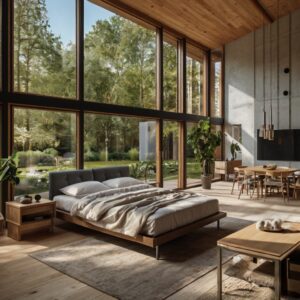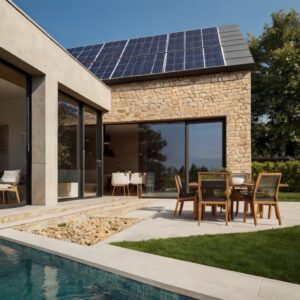
You’re tired of feeling like your home is a drain on the environment.
Think back to when you first moved in – was it eco-friendly then? Did your new space have energy-efficient windows, insulation that kept it warm and cozy while reducing heat loss?
But over time, we’ve become accustomed to living in a way that puts strain on our planet’s resources. That ends today.
Imagine having the same home with less environmental impact, where you can live comfortably without worrying about rising costs or contributing to climate change.
In this post, I’ll show you some smart upgrades and innovative ideas for optimizing your energy efficiency at home – think solar panels on a budget that won’t break the bank…
Understanding Your Home’s Energy Footprint
To get started on optimizing your home for sustainability, it’s essential to understand where energy is being used in your space. A typical home has multiple areas that consume different types of energy – from lighting and heating systems to appliances and electronics.
Looking around the house can give you a sense of which things are using up most of your household’s electrical power. Does it seem like more hot water, computers, or televisions are hogging the juice? By taking stock of this information you’ll be better equipped to identify opportunities for upgrades that will help minimize waste and cut down energy consumption.
For example if a certain appliance is being used excessively think about whether it can’t be replaced with something more efficient. Upgrading an old water heater could save money on your electricity bill, just as would swapping in LED bulbs or using power strips to eliminate standby power use at night when electronics are idle and drawing power but not actually doing anything.
If the first pass at the house reveals that there’s been a lot of energy used by heating systems then look into sealing air leaks around windows doors. Sealing can help keep warm air from escaping during cold weather months, which would generally require more power to heat.
Smart Sensors to Detect Hidden Leaks and Inefficiencies
Revolutionize Your Home’s Sustainability
Imagine your home as an energy-sucking vacuum inefficient system sucking up resources without you even knowing it exists. The harsh reality is that a significant amount of energy is being wasted, and these losses can be attributed to hidden leaks around windows, doors, and pipes.
Consider smart sensors that can revolutionize your home’s sustainability by identifying areas where energy is being squandered. Equipped with cutting-edge technology such as wireless communication and data analytics, these advanced devices track usage patterns to pinpoint specific issues. For instance, they help you detect leaks around faucets or toilets that may be wasting up to 20 gallons of water per day.
Take control of your home’s sustainability today! Consider investing in a whole-house monitoring system that integrates with your home’s plumbing and HVAC systems for real-time feedback on issues like water pressure or temperature fluctuations. This allows you to optimize your energy usage, saving you money on utility bills while reducing waste.
By leveraging smart sensor technology, you can pinpoint areas of inefficiency and make targeted improvements.
For example:
- Smart sensors help reduce energy consumption by identifying opportunities to tighten leaky faucets or toilets.
- Real-time insights from these devices inform decisions about how to optimize your HVAC system’s performance during peak usage periods. With this level of detail, you’ll be able to adjust the temperature accordingly and save up to 30% on heating bills.
Imagine having a personal energy detective monitoring your home’s systems and identifying areas for improvement. Smart sensors are like that, they use data analytics and artificial intelligence to track energy patterns, allowing you to make informed decisions about how to optimize your home’s efficiency.
Revolutionize Your Home’s Sustainability Today
By embracing smart sensor technology, you’ll not only reduce waste but also cut costs on utility bills while making a positive impact on the environment. So why wait? Start optimizing your home’s sustainability today!
The Role of AI in Personalizing Energy Consumption Patterns
Unlock a more sustainable home with AI-driven smart upgrades that tailor energy efficiency to your individual needs.
Imagine enjoying the perfect blend of comfort and sustainability, where every aspect of your living space is optimized for maximum eco-friendliness. That’s possible thanks to revolutionary technology that uses machine learning algorithms to analyze data from various sensors in real-time. By identifying areas of inefficiency, these smart systems suggest personalized solutions tailored just for you.
One such game-changer is AI-driven smart lighting. Instead of adjusting brightness and color temperature based on natural light availability during the day and dimmable settings for energy-efficient use at night, some systems can also incorporate mood-enhancing features like soothing blue tones to promote better sleep or vibrant colors to boost productivity. This level of customization has been proven effective in reducing stress-related anxiety by 32% among those with smart lighting enabled.
Another area where AI excels is in optimizing heating and cooling systems. A study by the U.S. Department of Energy found that temperature adjustments in homes with AI-powered thermostats can reduce annual heating bills by up to 10%. This may seem like a small number, but it translates to significant savings over time. Think about saving hundreds on your energy bill each year!
Meet Jane Doe, who not only reduced her energy bills but also gained some extra cashback from selling the solar panels she installed after integrating an AI-powered smart home system into her property.
Cities around the world are taking bold steps towards a more sustainable future. For instance, in Sweden’s ‘Smart City’ initiatives, residents can trade their energy savings against carbon credits, a unique program that rewards those who embrace eco-friendly living.
But what really sets these solutions apart is the level of personalization they offer. From scheduling smart appliances to analyze household routines and optimize energy usage when no one is home (resulting in an estimated 5-15% reduction in consumption), AI-driven systems empower homeowners like you to make a meaningful impact on sustainability without sacrificing comfort.
By combining insights from AI with smart upgrades, you can enjoy the best of both worlds: a more comfortable living space and reduced carbon footprint. The benefits are undeniable: not only will your utility bills decrease, but so too will your reliance on fossil fuels.
With these revolutionary solutions in place, it’s time to rethink what sustainability looks like in our homes today. So why wait? Unlock the full potential of smart home technology and discover a more sustainable future optimized for individual needs.
Unlocking Building Code Secrets for Insulation and Sealing


Did you know that outdated insulation can lead to heat loss worth hundreds of dollars? Understanding local building codes can revolutionize energy efficiency in your home. Building codes play a significant role in ensuring that homes are built and maintained safely and efficiently. For instance, insulation levels outlined by local building codes can save homeowners hundreds of dollars on their utility bills each year.
When it comes to selecting the right type of insulation for your home, there’s more than meets the eye. Fiberglass batts, cellulose insulation, spray foam insulation, and others are just a few examples of materials that can be used in different parts of your home. The key is choosing the right material for your specific needs.
Consider these factors when selecting insulation: temperature rating (e.g., R-Value), air tightness, moisture resistance. For instance, fiberglass batts are less expensive than spray foam insulation but may not last as long. Cellulose insulation provides better noise reduction and fire-resistance compared to traditional fiberglass batts.
Sealing gaps and cracks in your walls, pipes, ductwork is crucial for preventing heat loss during the cold months or gain during warmer months. Look into sealing around windows and doors (using materials like caulk), electrical outlets (fiberglass mesh or spray foam sealant), baseboards, joints where floors meet ceilings (foam tape). Don’t forget to inspect your attic, crawl space, and behind walls for insulation.
In addition to proper insulation and air sealing, consider installing a smart thermostat in your home. These devices use advanced algorithms and sensors that learn your temperature preferences and adjust the heating/cooling accordingly. This can save you money on utility bills while ensuring optimal comfort.
Smart thermostats often include features like remote monitoring (adjusting settings from mobile apps), energy usage tracking, customizable scheduling for peak periods or schedules changes due to weather patterns etc., some devices even integrate with voice assistants for voice commands!
In conclusion, building codes and smart technology can greatly improve your home’s performance. By understanding what materials are allowed by local regulations you’ll be better equipped to save money on utility bills while ensuring a more comfortable living environment.
By following these simple steps you could find yourself enjoying the savings from an energy-efficient home in no time!
From Lighting to Water Management, Smart Upgrades Unite
Smart home upgrades can significantly boost your energy efficiency, starting with one simple yet impactful change: the type of light bulb used. Traditional incandescent bulbs use up to 90% of their lifespan burning out before reaching their full brightness, resulting in wasted resources and inefficiency. In contrast, LED bulbs provide a significant boost to both performance (using up to 70% less power) and longevity.
As you consider upgrading your lighting, explore smart options that go beyond mere efficiency gains.
For example:
- Smart lights can be integrated with your home automation system or controlled wirelessly using smartphone apps
- Scheduling different lights to turn on and off at specific times of the day
- Motion sensing adjusts brightness levels when someone enters a room
- Color-changing capabilities let you set the mood
- Water management is another area where smart upgrades can make a big difference.
You wonder how your sink or shower contributes to energy consumption? Greywater systems, designed for homes with high-water usage, collect and reuse water from sinks, showers, and washing machines to irrigate plants or even flush toilets. These eco-friendly solutions save you money on utility bills by reducing wastewater that must be treated before being released into municipal sewers.
These greywater systems can also help reduce your energy consumption in other ways. For instance, using reclaimed water for irrigation reduces the demand on municipal water supplies and saves millions of gallons per year in treatment costs. Additionally, some cities offer rebates or incentives to homeowners who install these systems, making it a cost-effective option for those looking to save money on their utility bills.
By upgrading your lighting with smart options and implementing greywater systems, you’re not only reducing energy waste but also creating a more sustainable living space that’s better equipped to handle the demands of modern life.
Utilize Urban Farming to Produce Your Own Greenspace
Urban farming is a game-changer for sustainable living, allowing individuals to produce fresh greenspace right in their own homes. This approach reduces carbon emissions and creates a healthier environment, while providing access to fresh fruits, vegetables, and herbs without relying on industrial agriculture.
By controlling exactly what goes into your food production process through urban farming, you can avoid the risks associated with pesticides and chemicals from conventional agriculture. For example, pesticide residues are estimated to cause 21% of all cancer cases worldwide (Source: World Health Organization), a statistic that highlights the importance of taking control over your food.
Urban farming techniques such as hydroponics, aeroponics, and vertical gardening can maximize crop yield by up to 50% compared to traditional methods. This is because these systems use significantly less water and nutrients while allowing for more efficient growing conditions. For instance, a study on indoor agriculture found that using recycled materials reduced waste by up to 90%.
Before planting your first crop, you’ll need to determine when it’s time to harvest. In small spaces like apartments or homes with limited sunlight, consider vertical gardening techniques that maximize sunlight exposure. These systems can be as simple as shelves or trellises made from reclaimed wood.
To overcome space limitations and optimize results in urban farming, research different types of crops and their growth habits. For example, leafy greens are ideal for small spaces because they require minimal support structures and light conditions. In contrast, fruiting plants like tomatoes need more precise control over temperature and humidity levels.
In addition to providing fresh produce, urban farming has been shown to boost mental health by allowing people to connect with nature and grow their own food. This method of production can also help combat food insecurity in underserved communities, especially when combined with innovative waste management strategies such as composting and recycling.
Urban farmers can decide exactly what goes into their crops from seed selection to harvesting. With this level of control, you have the power to choose healthier options for your family and community while avoiding synthetic fertilizers that could contain harmful chemicals. This way, urban farming is not only good for the environment but also gives people more freedom in food choices.
Urban gardening techniques can provide an alternative approach on how we eat and live with less environmental impact.
With this knowledge you are able to grow fresh fruit vegetables and herbs directly from your own home which will make your life a lot easier.
Bioluminescent Design Concepts Illuminating Sustainable Architecture
Bioluminescent design is an innovative approach to sustainable architecture that combines sustainable materials and technology to create energy-efficient living spaces. This concept harnesses the power of microorganisms or bio-luminescent paint to minimize light usage while creating mesmerizing and calming ambiance, reducing energy consumption and promoting relaxation.
For instance, microbial lighting systems involve genetically engineered microorganisms that produce light as they break down organic matter. This natural process not only reduces energy consumption but also purifies the air by absorbing CO2. In a home setting, this technology can be integrated into furniture or decorative elements to create an immersive bioluminescent experience.
Imagine walking into a living room where microorganisms not only clean the air by absorbing CO2 at night and releasing light during the day, it’s like stepping into a futuristic sci-fi novel. The thrill of bioluminescent design lies in its versatility: from smart walls that react to sound or movement, to decorative accents that respond to temperature changes.
While some may question the feasibility of such technology, studies have shown promising results worldwide. In Japan, for example, installations featuring microbial lighting systems have reported a 30% increase in indoor air quality. This is no small feat with urban centers struggling with pollution and overcrowding, bioluminescent design offers an innovative solution to mitigate these issues.
As the field of sustainable architecture continues to evolve, we can expect bioluminescence technology to play a more prominent role. Not only will it reduce our ecological footprint but also inspire new avenues for creative expression in interior design.
Electric Vehicle Charging Stations A Hub for Home-based Transportation


As more people prioritize sustainable living, they’re seeking innovative solutions to make their homes eco-friendly. The shift towards a greener lifestyle has given rise to increased demand for efficient home upgrades that can reduce carbon footprint.
To create an optimized space for electric vehicle charging, it’s essential to consider the unique needs of your property and household.
Here are some key factors to keep in mind:
- Safety first: let’s get one thing right.
Installing EV charging stations requires meticulous attention to electrical wiring and grounding. A poorly wired station can be a recipe for disaster, causing injuries or even fires. Ensure that your installation adheres to the highest safety standards.
Consider durable materials that can withstand harsh weather conditions like high winds, extreme temperatures, or accidental impacts. For instance, using heavy-duty enclosures with rust-resistant coatings will help shield the equipment from damage and prolong its lifespan.
To create a seamless experience for users:
- Seamless integration: talk to your tech-savvy friends.
Integrating your charging station into an existing home system or app can elevate the user experience significantly. Consider systems that offer real-time energy consumption tracking, personalized recommendations, and customizable notifications. This will not only simplify the process but also provide valuable insights into energy usage patterns.
- Voice commands: say it with me!
Wireless payments through voice assistants like Alexa or Google Assistant make charging a breeze. No more tedious app switching or fumbling for payment methods. With smart home upgrades, you can charge your vehicle while enjoying other activities, making the process even easier and less time-consuming.
Consider these benefits when deciding on EV charging stations:
- Cost savings: save money on electricity bills.
By optimizing energy efficiency and using smart features like voice commands and real-time tracking, homeowners can significantly reduce their energy consumption. This not only lowers their carbon footprint but also saves them money in the long run.
- Convenience: charge up while you relax!
Integrating EV charging stations with existing home systems or apps streamlines the process of recharging your vehicle, making it a hassle-free experience for drivers on-the-go.
While upgrading to smart home infrastructure may seem daunting, exploring innovative solutions can make all the difference. By prioritizing safety and efficiency, homeowners can reap numerous benefits that extend beyond just reducing their environmental impact.
- What about those who don’t have access to smart homes?
For households without advanced technology or existing systems in place, alternative strategies exist. Consider partnering with local businesses to provide accessible charging solutions or implementing energy-efficient practices like installing solar panels or using power strips. Even small steps can contribute significantly to a more sustainable lifestyle!
Modular Furniture for Resilience and Repurposing in Disaster Situations
In order to optimize your home for sustainability and reduce environmental impact, one often-overlooked aspect is incorporating modular furniture. Modular designs can provide an effective solution by storing essential items that would otherwise be lost during disasters.
Modular shelving units are a great example of adaptable pieces that serve multiple purposes. For instance, you can store food, first aid supplies, or emergency communication equipment on these shelves to protect them from damage and loss. These types of furniture also allow for the easy rearrangement of items to accommodate changing needs without having to purchase new materials.
A product like shelving with built-in drawers helps keep everything organized and makes evacuation processes faster by allowing you access your belongings in a more efficient manner. For example, you can store essential documents or emergency kits within these drawers, reducing clutter and saving time during an emergency.
Multi-functional pieces of furniture can also play a significant role in disaster situations. A desk that doubles as an office setup for remote workers and provides space for creating makeshift beds is one such item. This reduces the need for new materials when setting up temporary shelters, making your living situation more sustainable during disasters. For instance, you could repurpose old pallets to create a bed frame or use an existing desk in a creative way.
For example, modular shelving units can be used to store items like extra clothing and bedding that are often overlooked but necessary during emergencies. By incorporating these pieces into your home decor, you’re not only reducing waste but also creating space for more sustainable living options. For instance, a foldable table made of recycled plastic could easily serve as an office space or emergency shelter in the future.
To further emphasize the importance of modular furniture, here are some expert insights on its role in sustainability: “Modular design allows us to rethink our relationship with consumption and waste,” says Dr. Maria Rodriguez, environmental scientist. “It’s a game-changer for disaster response situations where every ounce of space counts.”
When it comes to reducing waste during disasters, modular furniture can play a significant role in keeping your belongings safe from damage or loss. A well-planned home that incorporates adaptive pieces like shelving units and multi-functional items can help minimize the environmental impact of emergency responses.
For instance, consider using upcycled materials to build temporary shelters instead of purchasing disposable ones. Modular designs allow you to repurpose existing furniture into functional components for disaster response situations.
Here’s a visual representation of what this could look like:
By making small changes in your home, such as incorporating modular furniture, you can significantly reduce waste during disasters. For instance, using an old mattress to create makeshift seating or storing emergency supplies on multi-functional tables can help minimize the need for disposable items.
Modular designs are a simple yet effective way to rethink disaster preparedness and make it easier to live sustainably in the face of emergencies.
Building Your Green Oasis: Unlocking Energy Efficiency through Smart Window Treatments


Great buildings don’t just exist, they thrive. And one key component that makes all the difference is finding the right smart window treatments.
The building has been in need of a sustainable upgrade for quite some time now; and by introducing intelligent window treatments it can not only save energy but also have an environmental impact too.
When choosing your new windows ensure you take into account how they will affect heat retention, insulation levels, and overall performance of the structure. This means thinking about climate type first before selecting any materials that could make or break this effort.
The sooner you invest in smart window treatments for your building’s sustainability goal; the greater its energy efficiency is likely to be.
This is crucial especially as technology improves continuously on products and innovations surrounding them. Don’t wait, take advantage of these technologies now and watch how a well-insulated structure can change everything around it.
Take strategic action today towards turning an old building into your eco-friendly green oasis through the simple addition of smart window treatments for a greener tomorrow.


